
21. under construction: Hsinchu Glass Art Museum
Sensation Comes to Taiwan
Curator Ralf Schmitt chose international video artists whose work
involved glass for the inaugural exhibition on December 18th at the
Hsin Chu Municipal Glass Museum (Features article December 12th).
This ongoing video project is a way to bring internationalism into Hsin Chu.
The debut video was a compilation of Taiwanese artist Chen Cheng-Tsai
(Erik)'s
"hot" Melting Love that showed a woman kissing the glass video screen
contrasted with Italian artist Grazia Toderi's "cold" C'era in lei qualcosa
della fata
that showed a leaf swirling in a glass of water under a running tap.
For Chen, his video was too "hot" for some officials at the museum
who immediately removed the tape from view. After four unsuccessful
attempts to show Chen's work, the tape became missing. Curator Schmitt was
only told that people were too busy and would look for the missing tape
during the next week. It was apparent to the artist that this was a case
of moralistic censorship and as he stated: "this is a bad education for
the people of Hsin Chu." Should the people of Hsin Chu be denied to
view a wet kiss on glass?
written by Susan Kendzulak for Taipei Times
"The project is called "Z Tunnel" which explores the future strategies of
urban development. Using the new urban elements, we expect this project can
induce more vitality to the urban life.
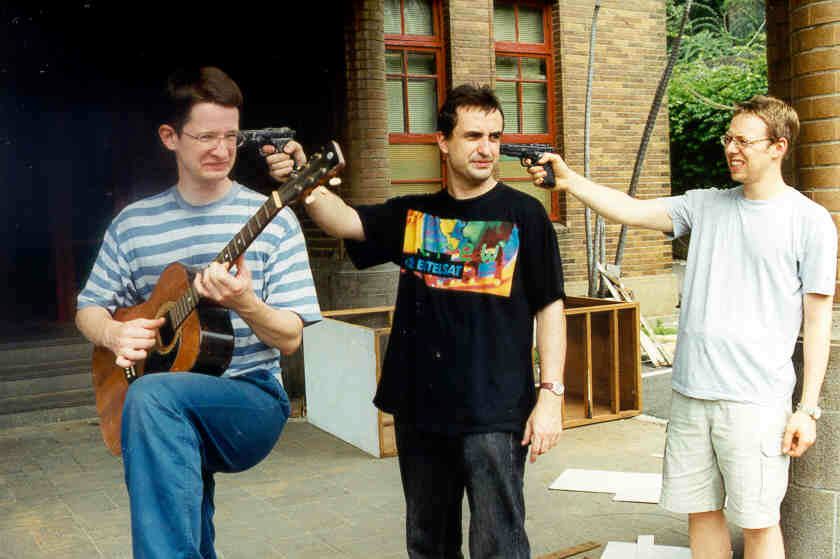
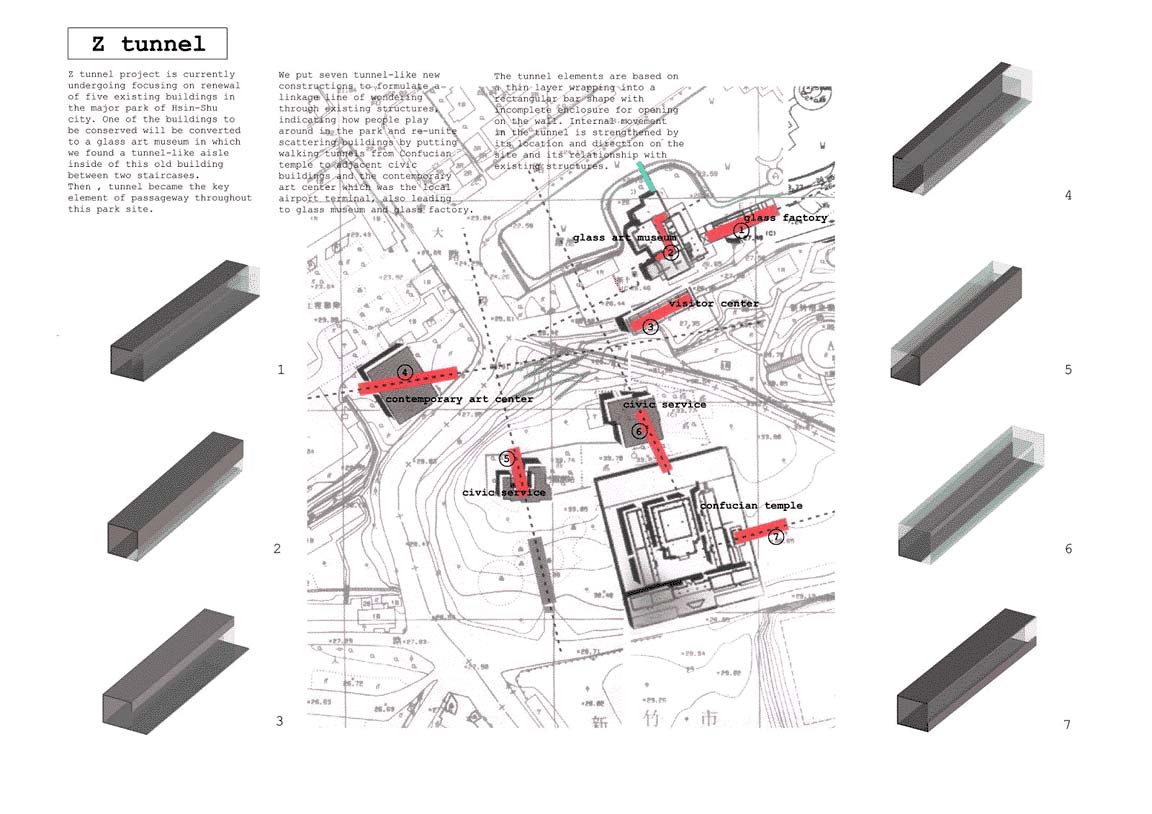
Glass art projects promoted by Ralf Schmitt, Foerderkoje Taipei
for Hsinchu Glass Art Museum, architect: Ti-Nan Chi
1. "Jail of Glass” (Stephanie Juenemann and Ralf Schmitt)
2. "when rabbitudes become form 1999” (Ralf Schmitt)(zoo much neon)
3. "Feng Shui Wall” (Ti-Nan Chi and Ralf Schmitt)
4. entrance lamp "light bulbs lamp” Christian Pantzer; ("beer chandelier” Andreas Schlaegel; not realized)
5. "rabbidragon Y2K” (on the entrance wall) (Ralf Schmitt);
6. "running thoughts” (future 7: Florian Wojnar and Nicolai von Rosen) (slide box for the base under the glass-staircase…not yet decided
7. video-compilation "video marbles” (for the z-tunnels) (Eric Chen, Saburo Teshigawara, Gracia Toderi, Rachel Toomey,….), curated by Manray Hsu and Ralf Schmitt
8. "leaded be” (three round windows out of stained glass with lead) (Ralf Schmitt)
9. two staircase-lamps "tube” (Christian Pantzer)
10. "garbage donation box” for the lobby (not (yet) realized) in the grown up garbage cans thoughts were thrown in by 5 idea-donators Simone Decker, Manray Hsu, Christian Pantzer, Andreas Schlaegel, Ralf Schmitt,
11. "trashy sound” (garbage can in front of the visitor center including a sound box)
12. "perhaps a visit from abroad” (octopus vulgaris in Hsinchu Temple)
(proposal for a slide box for visitor center) Simone Decker
13. "Broken-into-Infinite-Blessings Wall”
(broken tempered-glass-fillings in the visitor center) Ti-Nan Chi
Hearts of Glass
By Susan Kendzulak, December 9, 1999
The glistening bars of the tiny prison cell are glass; the last prisoner’s shoes, sleeping bag, wash basin, toothbrush and paste are also made of glass. Even the toilet he once used is now a laser-cut glass work. This room, once a prison for the Taiwan military, is now frozen in time and one of the many striking features of the new Hsin Chu Municipal Glass Art Museum and Glass Factory designed by Taipei-based architect Chi Ti-Nan. The "Jail of Glass," created by German artists Stephanie Juenemann and Ralf Schmitt, was handcrafted by Hsin Chu’s local glass artisans. As a material, glass transforms the function of a jail; the bars of glass, easy for any prisoner to break, makes forced confinement impossible and the jail’s intrinsic power and violence is now changed into a sparkling room straight out of a fairy tale. The grimy toilet and the prisoner’s remnants are now alchemized into dazzling magical objects of marvel; history becomes as clear as glass and frozen in space.
With an incredibly rich past, the museum’s building had been a hospital, a residence for the Japanese Emperor, a base for the U.S. Military and up to this year, a base for the Taiwan Military. Preserving the building’s history while creating an innovative and international museum was a major consideration for the collaboration between the architect Chi, his workshop and the Berlin-based artist label "Foerderkoje," founded by Schmitt, that invites other artists from around the world to contribute and develop their work
The Museum promises not to be your typical glass museum for it does not merely focus on glass "objets d’art" but includes a combination of cutting-edge art: language conundrums, neon displays, slide shows and videos; "Leaded be" stained-glass windows; and innovative architectural design such as a glass Feng Shui wall, an outdoor pedestrian glass bridge that connects two buildings, a screening room with Z-shaped benches and seven tunnel-like passageways to unify the separate buildings throughout the park such as a temple and a former airport check-in station. The Museum will also contain traditional elements such as exhibitions devoted to the history of glass, its various techniques - especially focusing on advanced glass technology in Taiwan - and temporary displays of new glass works.
Hsin Chu is a city renowned for its glass. The Museum’s official opening is December 18th to coincide with the start of the Hsinchu International Glass Art Festival. The Museum’s inaugural will feature a tunnel of "video marbles," various glass-inspired videos by artists from Italy, Japan and Taiwan installed in unexpected areas of the tunnels. In one video, a Japanese dance troop glissades over a sea of broken glass; in another, a woman’s moist tongue sensually licks a pane of glass.
The large green neon sign "when rabbitudes become form 1999" installed over the courtyard is an art historical pun. Thirty years ago, the phrase "when attitudes become form" signified the beginning of the idea as art, i.e. conceptual art. Amusingly enough, to translate "rabbitudes" into Chinese characters becomes "bearitudes." As Schmitt observes, perhaps the distinction between East and West is simply the difference between a bear and a rabbit.
The large handcrafted "Rabbidragon Y2K," peeking around the corner of a glass wall in the lobby, a clear glass rabbit that holds a bright orange carrot which becomes the dragon’s tail illustrates our fear of Y2K by using the Chinese animal symbols to show how one year slides effortlessly into the next.
To the followers of Aristotle, walking was equivalent to thinking which inspired "Running Thoughts," a slide box installed under the glass stairway that will project images of people walking interspersed with lamps; in this work light, glass and thought are linked. "Trashy sound" are recorded sounds from the "video marbles" emanating from the outside trash receptacle. "Broken-into-Infinite-Blessings Wall" are pieces of broken bluish glass inserted in a wave pattern on the outer walls of the visitor center that overlooks the lake.
In "zoo much neon," a directional sign, relates to the zoo adjacent to the museum and to the hit song by Taiwanese pop singer Lo Da-yo who sang that his hometown was no longer home because it had "too much neon." But when we see neon, we think of bin lang stands and night markets, the essence of Taiwan.
Hsin Chu Municipal Glass Art Museum, Tung Ta Road (Dong Da ?), Sec. 1, # 2. Grand Opening: December 18.
ARTICLE TAIPEI TIMES (pdf-File)
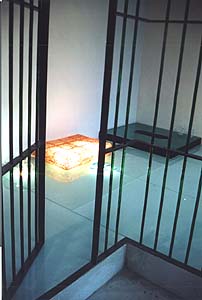
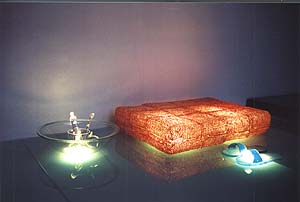
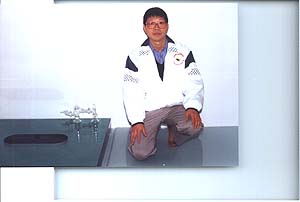
"when rabbitudes become form 1999”
(zoo much neon)
°u&Mac183;Ì&Mac186;A®&Mac223;&Mac197;&Mac220;¶®ßŒ¶°°A©Œ&Mac183;Ì&Mac186;µ´&Mac215;&Mac197;&Mac220;¶®ßŒ¶°°A1999°v
°u¿O&Mac173;i&Mac176; ™´&Mac176;œ°v
Thirty years ago in 1969, European curator Harald Szeemann organized an earth-shattering exhibition of a new art form: conceptual art, entitled "When attitudes become form: concepts - processes - situations - information." Art is not about physical objects like painting and sculpture, but about the idea; thought became the art form.
 §@§E§ª§E¶~°A¶Ë§Ë&Mac178;{•N&Mac195;¿&Mac179;Nµo•Õ§F§@•Û§j®&Mac198;°GªÆªÆ¶&Mac179;¶W™&Mac186;µ¶Æi§H•vøA&Mac176;“°]Harald Szeemann°^µ¶µe§F§@&Mac182;µ&Mac197;§—&Mac176; ¶a™&Mac186;Æiƒ&Mac253;°u&Mac183;Ì&Mac186;A´&Mac215;&Mac197;&Mac220;¶®ßŒ¶°°G&Mac198;[©¿°Bæ&Mac250;µ{°B&Mac179;B&Mac185;“°B&Mac184;Í&Mac176;T°v°Aµo&Mac176; §F°u&Mac198;[©¿&Mac195;¿&Mac179;N°v™&Mac186;&Mac183;s&Mac185;B&Mac176; °C&Mac195;¿&Mac179;N§£¶A•H¶&Mac179;ߌ™&Mac186;™´&Mac189;Ë°B™´•Û°]®“¶p&Mac195;&Mac184;µe°B¿J&Mac182;Ï°^¨&Mac176;µJ¬I°A¬‡¶”•Hß@´~&Mac173;I´·™&Mac186;&Mac198;[©¿¨&Mac176;Æ÷§&Mac223;°F¶]¶&Mac185;°Aß@´~™&Mac186;´‰&Mac183;Q&Mac186;ÎØ´°A§]¥N&Mac197;&Mac220;¶®§Fߌ¶°°C
§@§E§ª§E¶~°A¶Ë§Ë&Mac178;{•N&Mac195;¿&Mac179;Nµo•Õ§F§@•Û§j®&Mac198;°GªÆªÆ¶&Mac179;¶W™&Mac186;µ¶Æi§H•vøA&Mac176;“°]Harald Szeemann°^µ¶µe§F§@&Mac182;µ&Mac197;§—&Mac176; ¶a™&Mac186;Æiƒ&Mac253;°u&Mac183;Ì&Mac186;A´&Mac215;&Mac197;&Mac220;¶®ßŒ¶°°G&Mac198;[©¿°Bæ&Mac250;µ{°B&Mac179;B&Mac185;“°B&Mac184;Í&Mac176;T°v°Aµo&Mac176; §F°u&Mac198;[©¿&Mac195;¿&Mac179;N°v™&Mac186;&Mac183;s&Mac185;B&Mac176; °C&Mac195;¿&Mac179;N§£¶A•H¶&Mac179;ߌ™&Mac186;™´&Mac189;Ë°B™´•Û°]®“¶p&Mac195;&Mac184;µe°B¿J&Mac182;Ï°^¨&Mac176;µJ¬I°A¬‡¶”•Hß@´~&Mac173;I´·™&Mac186;&Mac198;[©¿¨&Mac176;Æ÷§&Mac223;°F¶]¶&Mac185;°Aß@´~™&Mac186;´‰&Mac183;Q&Mac186;ÎØ´°A§]¥N&Mac197;&Mac220;¶®§Fߌ¶°°C
In the sixties, artists used neon with weighty seriousness, and now, today's artists use neon in more playful, experimental ways stretching the medium as never before, as seen in Taiwanese artists Wang Jun-Jieh's "Neon Holiday" and Hsu Cheng-Ren's "An illusion more accurate than poetry."
¶b§ª§Q¶~•N°A¶Ë§Ë&Mac195;¿&Mac179;NÆaßQ•Œ¿O&Mac173;iøO&Mac179;–&Mac179;yß@´~°A§j¶hƒYµ¬¶”®H¥e°F§T§Q¶~´·°A&Mac178;{¶b™&Mac186;&Mac195;¿&Mac179;NÆa©&Mac185;©&Mac185;ßQ•Œ§Ò&Mac184;&Mac251;¿&Mac184;ζ°B´’¿q°B&Mac185;Í&Mac197;Á© ™&Mac186;§&Mac226;™k°A&Mac186;…&Mac182;q©µ¶&Mac249;¿O&Mac173;iøO™&Mac186;•i؇© °C•x&Mac198;W&Mac195;¿&Mac179;NÆa§&Mac253;´T&Mac179;«™&Mac186;°u&Mac183;•º÷•@¨…°Aø&Mac195;•&Mac250;§ßÆ»°v©M&Mac179;\¨@§H™&Mac186;°u§@&Mac173;”§Ò&Mac184;÷ßÛ&Mac183;«&Mac189;T™&Mac186;§¤ƒ±°v°A¥N¨O´&Mac220;¶n™&Mac186;®“§l°C
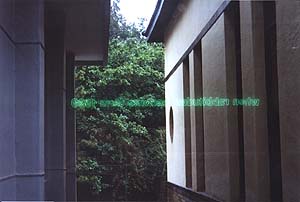
For the Hsin Chu Municipal Glass Art Museum, artist Ralf Schmitt, in honor of the Year of the Rabbit, presents his binlang green neon sign: "when rabbitudes become form 1999." An idea that had originated in the West thirty years ago, now comes to the East and incorporates ancient Chinese beliefs. The Chinese equivalent of "rabbitudes" is "bearitudes." Perhaps, the distinction between East and West is simply the difference between a bear and a rabbit.
¨&Mac176;§Fºyب&Mac183;s¶À¨¡º&Mac254;§u&Mac195;¿¿]™&Mac186;&Mac182;}¿]°AæA&Mac179;{§§&Mac176;Í™&Mac186;®&Mac223;¶~°Aº&Mac218;¨w&Mac195;¿&Mac179;NÆa¨I±KºwØSßO•H¬b&Mac183;}™&Mac186;&Mac186;Ò°A&Mac179;–ß@§F¿O&Mac173;iøOß@´~°A°u&Mac183;Ì&Mac186;A®&Mac223;&Mac197;&Mac220;¶®ßŒ¶°°A©Œ&Mac183;Ì&Mac186;µ´&Mac215;&Mac197;&Mac220;¶®ßŒ¶°°A1999°v°C§T§Q¶~´e¶Ë§Ë•X&Mac178;{™&Mac186;&Mac198;[©¿°A§T§Q¶~´·µ&Mac178;¶X§F§§&Mac176;Í™&Mac186;•j•N´H•&Mac245;°A&Mac173;´&Mac178;{™F§Ë°C®‰&Mac182;°™&Mac186;ÆtßO°A§£&Mac186;&Mac222;°u®&Mac223;°v©Œ°u&Mac186;µ°v°A®Ï©&Mac179;¶b®&Mac186;&Mac184;éO°H

"zoo much neon," a directional sign, relates to the zoo nearby the museum and to the song by Taiwanese pop singer Lo Da-yo who sang that his hometown was no longer home because it had "too much neon." Neon lights, so ubiquitous in Taiwan and a 1960s conceptual art medium in the West are now connected; the thirty year cycle is completed.
°u¿O&Mac173;i&Mac176; ™´&Mac176;œ°v™&Mac186;§Ë¶V´¸º–°A´¸ØA&Mac179;’™´¿]™&Mac254;™Ò™&Mac186;&Mac176; ™´&Mac182;È°A©M&Mac195;&Mac185;§j¶&Mac246;™&Mac186;¶W¶±°u&Mac179;¿¥‰§p¬Ì°v°]°u•x•_§£¨Oß&Mac218;™&Mac186;Æa°Aß&Mac218;™&Mac186;Æa&Mac182;m®S¶&Mac179;¿O&Mac173;iøO°v°^°C¿O&Mac173;iøO°A§ª§Q¶~•N¶Ë§Ë&Mac198;[©¿&Mac195;¿&Mac179;N&Mac179;&Mac223;&Mac183;R™&Mac186;ß&Mac247;&Mac189;Ë°A®Ï§F§E§Q¶~•N°A¶®¨&Mac176;•x&Mac198;W•|&Mac179;B•i®£™&Mac186;¨y¶Ê¥&Mac186;&Mac198;[°C©“ø&Mac215;§T§Q¶~&Mac173;&Mac183;§Ù&Mac189;¸¨y¬‡°A¨O§]°C
"rabbidragon Y2K”
°u&Mac249;&Mac184;°]&Mac173;µ£y£&Mac185;£&Mac182;£ø°^¶~2000°v
"The Year of the Rabbit will continue to the Year of the Dragon. For the coming of a new millenium in the Western calendar, rabbidragon was born to celebrate."
¨&Mac176;§F™Ô±µ¶Ë§Ë扙k™&Mac186;§d¡H¶~°A´Í¶n&Mac185;J§W§§&Mac176;Í扙k®&Mac223;¶~©M¿s¶~™&Mac186;ªŒ±µ°A§@&Mac186;ÿ&Mac183;s™&Mac186;&Mac176; ™´°u&Mac249;&Mac184;°v°]&Mac173;µ£y£&Mac185;£&Mac182;£ø°^¶b¶&Mac185;&Mac189;œ•Õ°C
NEXT
